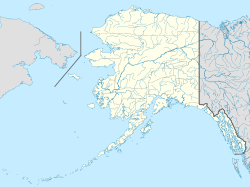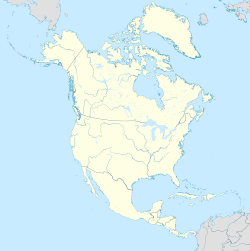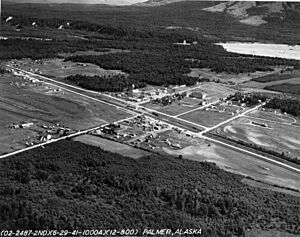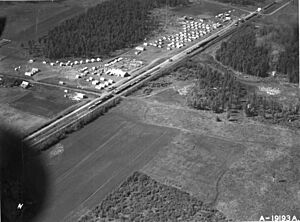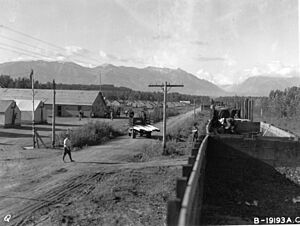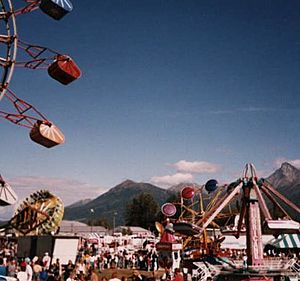Palmer, Alaska facts for kids
Quick facts for kids
Palmer
|
|
|---|---|
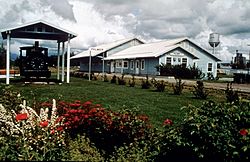
Palmer depot with a narrow gauge locomotive
|
|
| Motto(s):
"Alaska at Its Best"
|
|
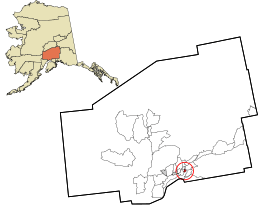
Location in Matanuska-Susitna Borough and the state of Alaska
|
|
| Country | |
| State | |
| Borough | |
| Incorporated | April 30, 1951 |
| Area | |
| • Total | 5.07 sq mi (13.14 km2) |
| • Land | 5.07 sq mi (13.14 km2) |
| • Water | 0.00 sq mi (0.00 km2) |
| Elevation | 233 ft (71 m) |
| Population
(2020)
|
|
| • Total | 5,888 |
| • Density | 1,160.88/sq mi (448.25/km2) |
| Time zone | UTC−9 (Alaska (AKST)) |
| • Summer (DST) | UTC−8 (AKDT) |
| ZIP code |
99645
|
| Area code | 907 |
| FIPS code | 02-58660 |
| GNIS feature ID | 1407737 |
Palmer is a city in Alaska, known as the main town of the Matanuska-Susitna Borough, Alaska. It's located about 42 miles (68 km) northeast of Anchorage in the beautiful Matanuska Valley.
Palmer is the ninth-largest city in Alaska. It's part of the larger Anchorage metropolitan area. In 2020, about 5,888 people lived here. The city is famous for hosting the yearly Alaska State Fair. It's also home to the National Tsunami Warning Center.
Contents
History of Palmer
Palmer was named after George Palmer, an early trader. In the late 1800s, the U.S. government became interested in the coal fields north of Palmer. This led to the idea of building the Alaska Railroad in 1904. During World War I, there was a high demand for coal. By 1917, the U.S. Navy had built a railway to the coal areas.
After World War I, land in the coal fields was given to war veterans. More land was opened for homesteading, which meant people could claim land to farm. Farmers, miners, and homesteaders began to settle in the area. The Palmer Post Office opened in 1917. With the railroad, farmers in the Matanuska Valley could sell their crops in new markets.
The Matanuska Valley Colony
In 1935, Palmer changed quickly. The government spent $11 million to create the town of Palmer. They moved 203 families from areas in Michigan, Minnesota, and Wisconsin that were hit hard by the Great Depression. These families traveled by train and ship to Palmer. They arrived in May 1935 and lived in tents during their first summer.
Each family received 40 acres (16 hectares) of land to farm. Many families struggled, but some stayed. Their descendants still live in the area today. Farms like Vanderwheele and Wolverine are still active. In 1971, the National Outdoor Leadership School started teaching wilderness skills here. They used the historic Berry House, which is now a protected historical site.
The families who moved here brought their small-town values from the Midwest. They helped create a well-planned city center. Many of the buildings from that time are now part of a national historic district. As roads improved and Anchorage grew, more people moved to Palmer. Many residents now travel about 45 minutes to work in Anchorage.
Geography and Nature
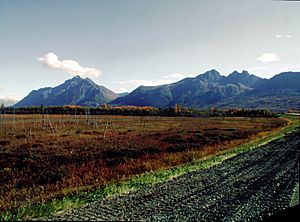
Palmer is located 42 miles (68 km) northeast of Anchorage on the Glenn Highway. It sits on the north side of the Matanuska River. The city is in a wide valley between the Talkeetna Mountains to the north and the Chugach Mountains to the south and east.
Mountains and Parks
Pioneer Peak is a tall mountain that rises over 6,000 feet (1,800 meters) above the town. East of Palmer are Lazy Mountain and Matanuska Peak. These are all part of the Chugach Range. To the north are the Talkeetna Mountains. Hatcher Pass is a popular spot for hiking, skiing, and other outdoor fun. It's about 22 miles (35 km) from Palmer.
The United States Census Bureau says Palmer covers about 3.8 square miles (9.8 square kilometers) of land. Palmer and Wasilla are the two main older towns in the Matanuska-Susitna Valley. The population in this area has grown a lot recently.
You can get to Palmer by road, or by air at the Palmer Municipal Airport. The Palmer Depot of the Alaska Railroad is also here. These don't have regular flights or train services. However, during the Alaska State Fair, the Alaska Railroad sometimes runs a special train from Anchorage to Palmer.
Climate in Palmer
Palmer has a subarctic climate. This means it has long, cold winters and short, mild summers. It gets more rain in the summer, with August being the wettest month.
Palmer's climate is similar to Anchorage's. However, Palmer's low temperatures are usually a bit cooler, and its high temperatures are a bit warmer. On average, each year there are about 28-29 days where the temperature drops below 0°F (-18°C). There are also about 22-23 days where the temperature reaches 70°F (21°C) or higher.
Palmer is located near two glaciers: the Matanuska Glacier and the Knik Glacier. Winds often blow through the Matanuska and Knik River Valleys into the town. If there's a lot of snow, it might stay for a few days before the wind blows most of it away. Warm winds, often called Chinook winds, can raise winter temperatures for a couple of days.
| Climate data for Palmer Municipal Airport, Alaska, 1991–2020 normals, extremes 1997–present | |||||||||||||
|---|---|---|---|---|---|---|---|---|---|---|---|---|---|
| Month | Jan | Feb | Mar | Apr | May | Jun | Jul | Aug | Sep | Oct | Nov | Dec | Year |
| Record high °F (°C) | 58 (14) |
62 (17) |
59 (15) |
73 (23) |
80 (27) |
86 (30) |
88 (31) |
85 (29) |
70 (21) |
67 (19) |
55 (13) |
52 (11) |
88 (31) |
| Mean maximum °F (°C) | 45.8 (7.7) |
46.5 (8.1) |
46.0 (7.8) |
58.9 (14.9) |
72.9 (22.7) |
76.7 (24.8) |
78.5 (25.8) |
74.5 (23.6) |
65.8 (18.8) |
57.1 (13.9) |
44.6 (7.0) |
44.7 (7.1) |
80.1 (26.7) |
| Mean daily maximum °F (°C) | 22.4 (−5.3) |
28.3 (−2.1) |
34.9 (1.6) |
47.8 (8.8) |
59.1 (15.1) |
65.7 (18.7) |
67.6 (19.8) |
64.6 (18.1) |
55.8 (13.2) |
42.3 (5.7) |
28.9 (−1.7) |
25.1 (−3.8) |
45.1 (7.3) |
| Daily mean °F (°C) | 15.4 (−9.2) |
20.8 (−6.2) |
25.5 (−3.6) |
38.8 (3.8) |
49.0 (9.4) |
56.3 (13.5) |
59.2 (15.1) |
56.4 (13.6) |
48.3 (9.1) |
35.4 (1.9) |
22.2 (−5.4) |
18.3 (−7.6) |
37.1 (2.8) |
| Mean daily minimum °F (°C) | 8.3 (−13.2) |
13.2 (−10.4) |
17.2 (−8.2) |
29.8 (−1.2) |
38.8 (3.8) |
46.9 (8.3) |
50.7 (10.4) |
48.2 (9.0) |
40.8 (4.9) |
28.6 (−1.9) |
15.6 (−9.1) |
11.4 (−11.4) |
29.1 (−1.6) |
| Mean minimum °F (°C) | −14.1 (−25.6) |
−8.0 (−22.2) |
−2.3 (−19.1) |
16.3 (−8.7) |
30.6 (−0.8) |
39.5 (4.2) |
45.1 (7.3) |
40.0 (4.4) |
28.9 (−1.7) |
14.0 (−10.0) |
−3.5 (−19.7) |
−8.2 (−22.3) |
−17.4 (−27.4) |
| Record low °F (°C) | −27 (−33) |
−39 (−39) |
−12 (−24) |
−8 (−22) |
22 (−6) |
35 (2) |
42 (6) |
32 (0) |
21 (−6) |
−3 (−19) |
−19 (−28) |
−25 (−32) |
−39 (−39) |
| Average precipitation inches (mm) | 0.65 (17) |
0.70 (18) |
0.47 (12) |
0.30 (7.6) |
0.62 (16) |
1.00 (25) |
1.60 (41) |
2.32 (59) |
2.08 (53) |
1.25 (32) |
0.66 (17) |
0.96 (24) |
12.61 (321.6) |
| Average precipitation days (≥ 0.01 in) | 6.2 | 6.1 | 4.6 | 3.9 | 6.7 | 8.7 | 11.9 | 14.3 | 13.3 | 8.9 | 5.6 | 7.7 | 97.9 |
| Source 1: NWS (mean maxima and minima 2006–2020) | |||||||||||||
| Source 2: NOAA | |||||||||||||
People of Palmer
| Historical population | |||
|---|---|---|---|
| Census | Pop. | %± | |
| 1940 | 150 | — | |
| 1950 | 890 | 493.3% | |
| 1960 | 1,181 | 32.7% | |
| 1970 | 1,140 | −3.5% | |
| 1980 | 2,141 | 87.8% | |
| 1990 | 2,866 | 33.9% | |
| 2000 | 4,533 | 58.2% | |
| 2010 | 5,937 | 31.0% | |
| 2020 | 5,888 | −0.8% | |
| U.S. Decennial Census | |||
In 2010, Palmer had 5,937 people living in 1,472 households. About 47.4% of households had children under 18. Most people in Palmer (80.9%) are White. Other groups include Native American (8.2%), Black or African American (2.1%), and Asian (1.1%). About 3.5% of the population is Hispanic or Latino.
The average age in Palmer was 29 years old. About 33.6% of the population was under 18. For every 100 females, there were about 98 males. The average income for a household was $45,571.
Arts and Culture
Alaska State Fair
Palmer is most famous for the yearly Alaska State Fair. This fair celebrates Palmer's farming history. People compete to grow the largest vegetables, like giant cabbages, radishes, and spinach. Many national and even world records have been set here!
The fair also has carnival rides, fun activities, and local artists showing their work. You can find local vendors and food trucks. Popular music artists perform at the ConcoPhilips Borealis Theatre. In 2008, Scott Robb from Palmer won $2,000 for his 79.1-pound (35.9 kg) cabbage!
Palmer Museum of History and Art
In downtown Palmer, there's a log cabin Visitor Information Center. Over 35,000 visitors come here each year. In the summer, a gardener takes care of 2 acres (0.81 hectares) of public gardens. These gardens show off over 600 types of plants grown locally.
The Palmer Museum of History and Art is inside the Visitor Information Center. It has old items from Palmer's past. You can get maps to historical places and guidebooks about local attractions.
The Church of a Thousand Trees
A few blocks from the Visitor Information Center is the United Protestant Church. It's also called The Church of a Thousand Trees. This Presbyterian church was built in 1936–37. It's one of 17 buildings in the Matanuska Colony Historic District that are recognized nationally.
Friday Fling
The Friday Fling is a local event held downtown near the public library and train depot. Many small local businesses and farmers come together to sell their goods. It's a fun way to experience the community.
Parks and Outdoor Fun
About 12 miles (19 km) north of Palmer is Hatcher Pass. This beautiful mountain pass is a state park. It's home to the Independence Mine. Hatcher Pass is a popular place for skiers, snowboarders, and hikers. It's also a big tourist spot in the summer.
The area also has the Kepler-Bradley Lakes State Recreation Area. This park gives you access to many small lakes. There's also the Finger Lake State Recreation Area and several city parks.
Sports in Palmer
The Mat-Su Miners are a baseball team in the Alaska Baseball League. This is a high-level summer league for college players. The Miners play their games at Hermon Brothers Field at the State Fairgrounds. High school bands play music, and vendors create a lively atmosphere. The Miners have won the National Baseball Congress championship twice.
Alaska Raceway Park is a dragstrip nearby. The Valley Steelers, a semi-pro football team, play their home games at Palmer High School.
Education in Palmer
Schools in Palmer are part of the Matanuska-Susitna Borough School District. Within the city, there are two elementary schools (Swanson Elementary and Sherrod Elementary). There is also one middle school (Palmer Jr. Middle School) and one high school (Palmer High School).
Palmer High School is a good size, with 649 students and 73 staff members. In 1999, it became the first school in Alaska to offer the International Baccalaureate program. This program is a challenging course of study. About ten minutes away is their rival school, Colony High School.
Palmer is also home to Alaska Bible College. This is Alaska's only accredited school for theology and ministry. Matanuska-Susitna College is also here. It's an extension of the University of Alaska Anchorage.
The Palmer Alaska Job Corps is a program that helps young people learn job skills. It's located at 800 E. Lynn Martin Drive.
The Ya Ne Dah Ah School (YNDA School) is run by the Athabascan Nation Chickaloon Village. It teaches children using traditional Alaska Native methods. It was started in 1992.
Notable People from Palmer
- Charlie Akers (1939-2016), an Olympic biathlete.
- Corey Cogdell (born 1986), won two Olympic bronze medals in trap shooting.
- Edna DeVries (born 1941), a former Mayor of Matanuska-Susitna Borough.
- Anna Marly (1917–2006), a Russian-French singer-songwriter who lived in Lazy Mountain.
- Ed Walker (1917–2011), the last surviving member of "Castner's Cutthroats," a special forces unit.
- Talis J. Colberg (Born 1958), a former Attorney General of Alaska.
Sister Cities
Palmer has a sister city relationship with Saroma, Hokkaido, Japan. This partnership began on October 28, 1980. It helps promote cultural exchange and a home-stay program for residents.
The idea started with a friendship between Mr. Mutsuhiro Ishiguro, an English teacher in Saroma, and Palmer resident Edward Holmes. They met through their ham radios and became friends. Mr. Holmes visited Saroma, which led to a group from Saroma visiting Palmer. They then signed the sister city agreement.
Since then, more connections have formed:
- Palmer High School and Saroma High School (since 1991)
- Palmer Junior Middle School and Colony Middle School with Saroma Junior High School (since 2003)
- Pioneer Peak Elementary School with Saroma Elementary School (since 1991)
- Palmer Presbyterian Church with Saroma Christian Church
The Palmer Saroma Kai (パーマ・サロマ会) manages this sister city relationship.
See also
 In Spanish: Palmer (Alaska) para niños
In Spanish: Palmer (Alaska) para niños


